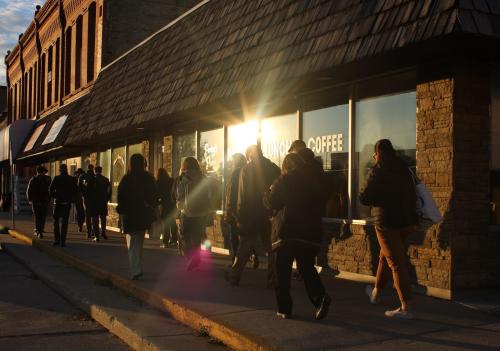In the weeks since Freddie Gray’s death and the destruction and violence that followed, thoughtful people throughout the nation have been trying to make sense of what happened in Baltimore, why it happened, and what comes next. On living room sofas, in local bars, on the radio, and in blog posts, long overdue conversations are occurring about policing and race relations, poverty and unemployment, welfare and single parenthood, drug policy and incarceration, and a range of other issues that might explain why a distressed community came undone. From such discourse come many narratives, some sad, some determined, some novel, some revolutionary, and some out of touch—which brings us to “There Are No ‘Two Baltimores,’” by Annie Linskey in the Boston Globe.
The article’s thesis is that Baltimore does not suffer as much from inequality—stark differences between the haves and have-nots—as it does from deep poverty. Indeed, several measures support that view. Baltimore’s poverty rate of 23 percent ranks it in the top quarter of large American cities. As one of us pointed out in the article, Baltimore’s relatively high income inequality owes more to the low incomes of its poor households than to the high incomes of its rich households. Linskey is correct, too, that Baltimore suffers from very high rates of violent crime; its homicide rate was fifth-highest among U.S. cities in 2013.
And yet to assert that there is no “rich Baltimore” misrepresents the facts. Baltimore has lots of wealth. You can find much of it in the thriving downtown area only a couple of miles from Freddie Gray’s Sandtown-Winchester, in vibrant neighborhoods along the waterfront, and in leafy communities throughout the northern part of the city. In 2013, 40,000 Baltimore households earned at least $100,000. Compare that to Milwaukee, a similar-sized city where only half as many households have such high incomes. As our analysis uncovered, jobs in Baltimore pay about $7,000 more on average than those nationally. The increasing presence of high-earning households and good jobs in Baltimore City helps explain why, as the piece itself notes, the city’s bond rating has improved and property values are rising at a healthy clip.
Much of the article’s case rests on a comparison of Baltimore to Boston, where most Globe readers live. Relative to Baltimore, Boston’s poverty rate is lower, its local finances are healthier, and it suffers far fewer homicides. But Boston is more the exception in urban America than the rule. The juxtaposition of assets and affluence on the one hand and deep distress on the other characterizes not only Baltimore but Houston, Chicago, Los Angeles, Philadelphia, and indeed most major cities and regions in the United States today. Our research and that of others demonstrates this uncomfortable truth.
The most inexplicable aspect of the article is the reference to “Murder Mall” as a “widely used shorthand” for the Mondawmin Mall where the riots originated. Frequent shoppers there (which includes one of us) have never heard that moniker.
To be sure, Baltimore has deep problems, but it also has diversity, culture, and the untapped potential of people who need more and better opportunities to participate in the prosperity many of us—in Baltimore and beyond—take for granted. That story needs to be told, as it is critical to the ability of the city’s residents to find and keep quality employment, of local businesses to grow, and of all neighborhoods to flourish.
The Brookings Institution is committed to quality, independence, and impact.
We are supported by a diverse array of funders. In line with our values and policies, each Brookings publication represents the sole views of its author(s).



Commentary
Yes, there are two Baltimores
May 15, 2015